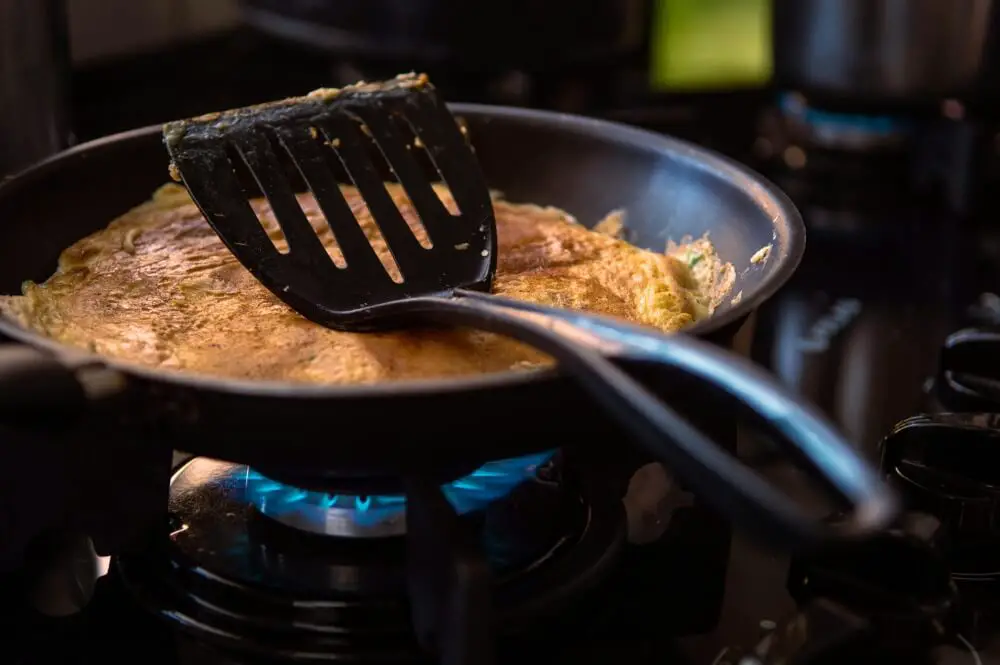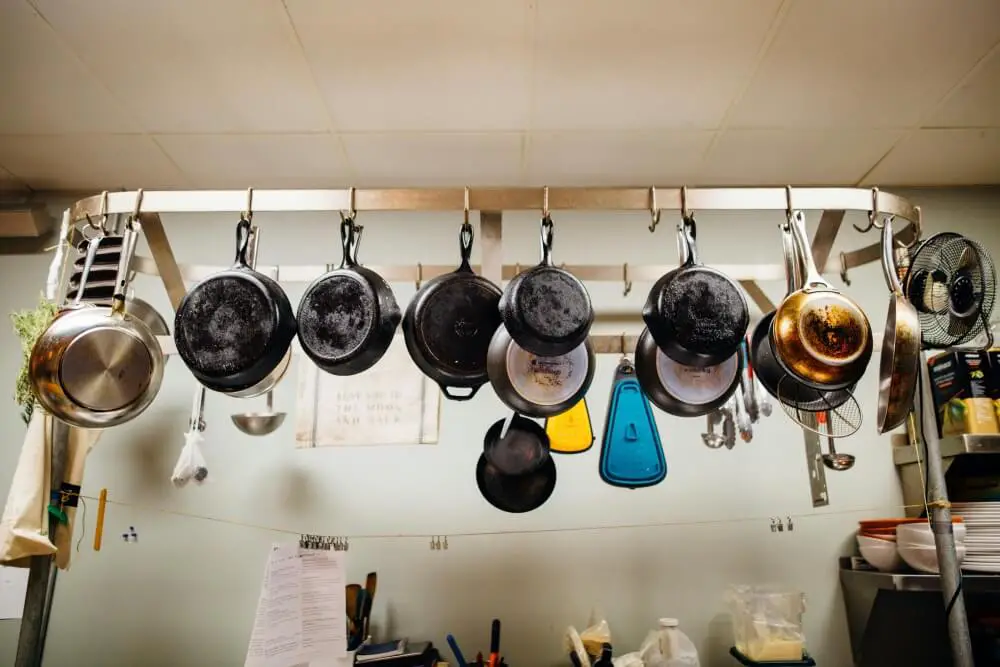I love cooking with a cast iron skillet, but if you’ve never used one before you’re probably wondering what all the hype is about. So what’s the big difference between a cast iron skillet and a frying pan?
A cast iron skillet is great for things that need seared and then baked in the oven, like steak, and for cooking on an open flame, like a campfire. Frying pans are great for things that need to be cooked quickly, like sauteeing vegetables, or that need to be cooked gently and not get stuck to the pan, like fish.
There are a few other differences such as how to care for the pans that we’ll discuss in this post. So, grab your apron and get ready to dive into the sizzling world of cookware showdowns.,
Table of Contents
What is A Cast Iron Skillet?

A staple in kitchens around the world, the cast iron skillet is a versatile piece of cookware that has stood the test of time.
For something to be considered cast iron, the iron has to have more than 2% carbon content and between 1-3% silicone content. If it has less carbon content then it is considered steel or carbon steel.
This material is then cast into the desired shape for the cookware which can range from a cast iron skillet with high straight sides, to a cast iron pan with low rounded sides.
The word skillet refers to a cookware item that has a deep base and straight sides. Cast iron skillets can also come in a variety of different sizes ranging from fitting a single egg to being able to deep fry a chicken.
With its sturdy construction and ability to retain heat evenly, a cast iron skillet is a valuable tool for searing, baking, frying, and more. However, because of the material they are made of, cast-iron skillets tend to be much heavier than other pans.
What Is a Frying Pan?

A frying pan, also known as a saute pan or fry pan, is a versatile piece of cookware commonly found in kitchens worldwide. They are usually made of many different materials such as stainless steel, aluminum, or copper and frying pans typically have a flat bottom and slightly sloped sides.
These sloped sides make it easy to get a spatula under and flip things like eggs and pancakes which is difficult to do with the higher sides of a skillet.
Frying pans are used for a wide range of cooking methods, such as sautéing, frying, and pan-searing. While not as heavy as a cast iron skillet, frying pans still provide an even distribution of heat for cooking delicious meals.
Next, let’s explore the differences between a cast iron skillet and a frying pan.
Cast Iron Skillet Vs Frying Pan

Now that we know what we’re working with, let’s explore the differences between a cast iron skillet and a frying pan in five categories: materials and construction, heat distribution and retention, versatility of cooking methods, maintenance and care, and price.
The biggest visual difference between a cast iron skillet and a frying pan is the vertical sides. A cast iron skillet will have higher sides whereas a frying pan will have lower sides giving it a shallow depth.
Whether you’re a home cook or a professional chef, with all this information you’ll be able to make the right decision about what kind of cookware you need in your life.
We’ve got a lot to talk about regarding these two kitchen essentials, so let’s get to it.
1. Materials and Construction
A cast iron skillet is typically made of thick, heavy cast iron, while a frying pan can be made of a variety of materials such as stainless steel or copper.
The way cast iron skillets are constructed contributes to their ability to retain and distribute heat evenly, making them ideal for achieving a perfect sear on steaks or crispiness on fried foods.
In contrast, frying pans are made of lighter-weight materials that may not offer the same level of heat retention or distribution, resulting in uneven cooking. But, the lighter materials also make it much easier to move around while cooking.
The materials and construction of cast iron skillets make them last an extremely long time. I got an old cast iron from my grandmother (who knows how old it is) and, after a round of cleaning and seasoning, it now looks brand new.
Understanding the materials and construction of these cookware pieces can impact the way you use them in your kitchen. Let’s now delve into how this affects their heat distribution and retention.
2. Heat Distribution and Retention
Heat distribution and retention play a crucial role in the performance of a cast iron skillet versus a frying pan.
The thick, heavy cast iron construction of a skillet allows it to distribute heat evenly and retain it for a longer period, resulting in long-term consistent cooking temperatures.
But, they also take longer to heat up initially which can cause some issues if you’re not used to cooking with cast iron. You have ‘preheat’ them before adding food just like you do with the oven.
On the other hand, frying pans made of lighter materials may struggle to distribute heat evenly, leading to hot spots and unevenly cooked food. But, this can be combated by stirring your food to ensure even heat distribution.
The lightness of the frying pan makes them heat up and cool down more quickly than cast iron which can be good for things that need to be done quickly like sauteeing vegetables.
3. Versatility in Cooking Methods
Aside from heat distribution and retention, the versatility of cooking methods is another one of the key differences to consider when deciding between a cast iron skillet and a frying pan.
A cast iron skillet can be used for a variety of cooking techniques, including searing, frying, baking, grilling, and even cooking in the high temperatures of a campfire.
Its ability to withstand high heat makes it perfect for achieving a beautiful sear on meats or caramelizing vegetables. And, it’s especially well suited for transitioning from the stovetop directly to the oven.
A frying pan is typically designed for quicker, stovetop cooking tasks which makes it more limited in the versatility aspect. But that makes it no less an essential item in any kitchen.
Understanding the versatility of cooking methods between these two cookware options will help you determine which one best suits your culinary needs.
4. Maintenance and Care
Proper maintenance and care are essential for ensuring the longevity and performance of both cast iron skillets and frying pans but, cast iron skillets are slightly more labor intensive.
For cast iron skillets, it’s crucial to season them regularly. This helps create a natural, non-stick cooking surface and prevent rusting. Seasoning is done by applying a thin layer of oil and heating it in the oven so that the oil can penetrate the pores of the pan.
One thing to keep in mind with cast iron is you don’t want to use metal utensils on them. This can scratch and damage the seasoning, exposing the iron beneath.
You also need to make sure to avoid using harsh detergents or scrubbing too vigorously on your cast iron, as this can strip away the seasoning. The best practice is to wash your cast iron in the sink with a gentle detergent and allow it to dry fully before storing to prevent rust.
You should never put your cast iron skillet in the dishwasher. The dishwasher detergent combined with the high heat will strip your hard-earned seasoning right off the cast iron.
Most commercial or stainless steel pans can be put directly in the dishwasher. However, the coating on a nonstick skillet can be damaged by the dishwasher or hard detergents.
For a nonstick pan, you should wash it with mild soap and warm water. As with cast iron skillets, you should not use metal utensils on nonstick fry pans because the metal can scratch and damage the nonstick coating.
It’s also important to store both types of cookware in a dry place to prevent moisture from causing rust.
As you can see, cast iron skillets are slightly more labor intensive, but they are similar to the care required of non stick frying pans.
5. Price
When it comes to price, cast iron skillets tend to be more expensive upfront compared to traditional frying pans. However, their durability and longevity make them a valuable investment in the long run.
Cast iron skillets can last for generations with proper care, making them a cost-effective choice over time. On the other hand, frying pans with non-stick coatings may need to be replaced more frequently, increasing their overall cost in the long term.
Both a cast iron skillet and a frying pan are a worthy addition to any home-cooks kitchen, each has its own strengths and weaknesses.
As you embark on your culinary journey, embrace your cookware with care and watch your dishes sizzle to perfection. As Julia Child once said, “The only time to eat diet food is while you’re waiting for the steak to cook.”
Related Questions
Is Cast Iron Better For Frying?
A cast iron skillet is great for frying since it has deep sides and the cast iron will help keep the oil at a more consistent temperature. But, you can also get skillets made out of other materials which can also be good for frying.
What Shouldn’t You Cook in Cast Iron?
The main thing you shouldn’t cook in a cast iron skillet is acidic foods. The acid in these foods will break down the protective seasoning on the cast iron. You should also be careful when cooking delicate foods such as fish or eggs in cast iron.
Wood Vs. Plastic Cutting Board
A wood cutting board will last longer but requires more upkeep and is more expensive upfront than a plastic one. A plastic cutting board is easy to clean and is usually inexpensive but they’re not as durable as wooden cutting boards. For a full comparison check out this post: Wood Vs Plastic Cutting Boards: Which Board is Better

